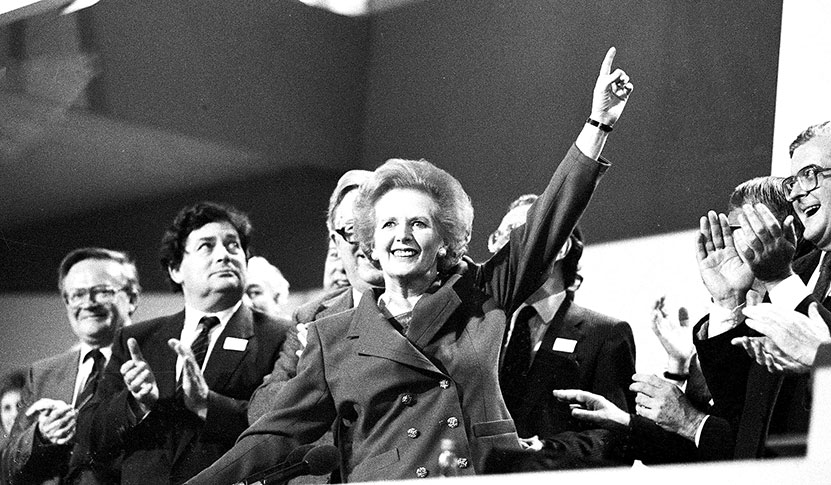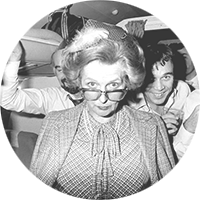Think
Margaret Thatcher
"Here I stand before you tonight, in my gauzy dress of Red Star
my face lightly made up and my blonde hair delicately waved
and my blonde hair delicately waved.
The Iron Lady of the Western world...".

Like other European statesmen of the second half of the 20th century (for example, Konrad Adenauer in the Federal Republic of Germany or Charles de Gaulle in France), Margaret Thatcher set her mission on the reconstruction of her country. But unlike Adenauer or de Gaulle, leaders of two countries defeated in the Second World War, for whom rebuilding meant rebuilding the nation and putting a state back on its feet, for Thatcher, almost three decades later, rebuilding meant healing her country from within, ridding it of what she saw as the causes of the sclerosis that had afflicted British society since 1945 and threatened to destroy it.
Another notorious difference that distinguished Thatcher from the other two statesmen was, of course, that she was a woman. That Margaret was Margaret - that is, a woman - was a fact that went unnoticed by anyone, but at a popular level was never a source of clear antipathy, let alone rejection. Quite another thing were the reactions of aversion and profound dislike that the female figure of Thatcher aroused in two very significant sectors of British public opinion in those years: the one formed around the strongly dominant machismo of the British political class and the one represented by a left-wing feminist lobby, doubly resentful of Thatcher's right-wing status and her declared adherence to English "conventional values". On the other hand, it is not easy to determine to what extent, among Thatcher's closest associates, a residue of resentment towards her for breaking with a long tradition of male leadership in British politics survived to the end. In this respect, however, the strong sense of relief among many of her government and Conservative Party colleagues in 1990 at the news of Thatcher's decision to end her political career was telling.
 But the controversy was to dog Margaret Thatcher throughout her life. Not only because of who she was and what she represented - a woman in politics - but also because of what she said and did. For many of her supporters, especially the younger generation of British conservatism, the policy measures she put in place represented a coherent whole which, as a more or less structured system or ideology, was being exported to other Western countries - especially the United States under Ronald Reagan. For the anti-Thatcherites on the left, things were totally different. For, while admitting her strong personality and charisma, they thought that Thatcher was no big deal either; that the The Prime Minister merely followed the most controversial and radical prescriptions of a set of neo-liberal economists with little judgement of her own.The American Milton Friedman or the Austrians Friedrich Hayek and Ludwig von Misses, all of them characterised by their anti-state fanaticism and their equally fanatical worship of the market and money.
But the controversy was to dog Margaret Thatcher throughout her life. Not only because of who she was and what she represented - a woman in politics - but also because of what she said and did. For many of her supporters, especially the younger generation of British conservatism, the policy measures she put in place represented a coherent whole which, as a more or less structured system or ideology, was being exported to other Western countries - especially the United States under Ronald Reagan. For the anti-Thatcherites on the left, things were totally different. For, while admitting her strong personality and charisma, they thought that Thatcher was no big deal either; that the The Prime Minister merely followed the most controversial and radical prescriptions of a set of neo-liberal economists with little judgement of her own.The American Milton Friedman or the Austrians Friedrich Hayek and Ludwig von Misses, all of them characterised by their anti-state fanaticism and their equally fanatical worship of the market and money.
However, regardless of the judgement that, with greater or lesser justification, can be attributed to her political action, one thing seems clear: Margaret Thatcher was not a politician of the moment. From the beginning to the end she promoted a programme of restoration partner-economics. Firstly, to restore the nation's self-confidence and international prestige, and secondly, to restore the United Kingdom's international prestige. And secondly, to restore or restitute to British society those rights and powers that had been "confiscated" (she would say) or monopolised by the state since the end of the Second World War. For the woman who was to be known as the Iron Lady, carrying out this work of restoration involved the implementation of a series of measures:
|
2. the payment of public and foreign debt; 3. "giving their money back to the people" by means of a large tax reduction (so that citizens could use it as they saw fit); 4. the denationalisation and subsequent privatisation of companies nationalised by the state during the post-war period; 5. the transfer to citizens of public housing for which they were paying rent to the State; 6. the dismantling of the network of institutions and instruments used by the state to intervene in the economy and markets (particularly trade unions and other corporate organisations). |
All these measures were aimed at putting an end to state interventionism. In other words, the statist excesses introduced into British society and the economy by the so-called post-war consensus between Labour and the Conservatives, which had been in place for the past 30 years. For Thatcher, the policies born of that consensus were the enemy.
Throughout her career, Margaret Thatcher was to break many records - apart of course from being the first female Prime Minister of the United Kingdom. She was also the healthiest and most physically strongest Prime Minister in modern British history, position , as evidenced by the fact that she was the Prime Minister with the fewest hours lost to leave . Also in terms of health, Thatcher deserved the appellation of iron lady universally attributed to her by so many analysts and journalists (not always with good intentions). Her record-breaking career did not stop there. He was also the longest-serving Prime Minister at position. He was also the Prime Minister with the highest number of electoral victories.
Apart from her self-control in public, the Iron Lady - or those who wrote her speeches - possessed a lively, quick-witted and delicate sense of humour, in the good English tradition, it was noted grade . She began her famous speech on the growing militarism of the USSR by saying:
"I stand before you tonight in my Red Star chiffon evening gown, my face softly made out and my fair hair gently waved. The Iron Lady of the Western World..."
Here I stand before you tonight, in my Red Star-coloured chiffon gown, my face lightly made up and my blonde hair delicately waved. The Iron Lady of the western world...'.
Incomparable strength of character, formidable commitment and legendary staying power enabled Thatcher to achieve her goals. But there was more. As with other great figures of the 20th century, such as the aforementioned de Gaulle or Winston S. Churchill himself, Thatcher was able to ride her luck and make the best of the fortunate circumstances that came her way. The circumstances that led her to take over the leadership of the Conservative Party in 1975 provide an illustrative example of her skill ability to avoid the miscalculations of her opponents and competitors, and to take advantage of the opportunities that arose. All this despite having to start from a clearly disadvantageous position. Indeed, looking back on this event, it is still surprising that a woman who lacked support in the very masculine sanctum sanctorum of British Conservatism managed to win the leadership of the party and then revolutionise that same traditional and hierarchical British Conservatism. By February 1975, however, the Conservative Party was so demoralised by two successive electoral defeats to its Labour rivals, and so divided by the resignation of its former leader, Edward Heath, that none of Heath's natural successors could muster the courage to stand for the party leadership. Against all odds, however, and to everyone's surprise, Margaret Thatcher did. And not only did she succeed in winning the leadership of the Conservative Party, but she proved to be strong enough to win the Conservatives the 1979 general election and turn British politics upside down in the process.
A few snippets of how the Iron Lady rules the noisy and chaotic meetings of the British parliament. An admirable control indeed.
Thus, on 4 May 1979 Thatcher became the new tenant of Downing Street. As noted above, her premiership lasted until 1990. During that long decade she was to introduce a profound change in the hitherto prevailing understanding of how the state and government were to operate in society. In this connection, it is said that at the beginning of her term in office, at a meeting with her party colleagues, Thatcher displayed a hardback book entitled The Constitution of Freedom, authored by the aforementioned neoliberal economist Friedrich Hayek. Once shown the book, the Prime Minister exclaimed: This is what we believe in!!!! Supported by ideas like Hayek's, but also acting through her own convictions, and through her unquestionable leadership and seductive oratory, Margaret Thatcher, the Grantham grocer's daughter, was to lead what not a few analysts called the "Conservative Revolution". No one like her was able to change the course the UK had been on for more than three decades. Like very few others, the Iron Lady also showed how to enthuse her numerous supporters and to silence -if not intimidate- her detractors, who were also not few in number.
Of course, Thatcher was not all hits. There were also mistakes. And some more or less, shall we say, dubious legacies can be attributed to her. For example, the one that stemmed from her insistence that one had to look favourably on the markets and oneself and with suspicion on the state. With that statement, perhaps unintentionally, Thatcher contributed to the spread of the idea that "politics is the problem and economics is the answer". The pernicious effects of that belief have become abundantly clear over the years.

|
|
Alvaro Ferrary. Specialist in Contemporary History, Professor of History at the University of Navarra. (March 4, 2020)

 Margaret Hilda Thatcher (née Roberts) was born on 13 October 1925 in Grantham, Lincolnshire, in the East Midlands. She lived an austere childhood, under the demanding authority of her father, Albert Roberts, an enlightened grocer who became an alderman (alderman) of the city and who educated his daughter in the strict Wesleyan Methodist discipline . He studied at Oxford University, where he obtained a Degree in chemistry. It was also at Oxford that he discovered his passion for politics. She immediately joined the Conservative Party, an organisation to which she always felt strongly committed. At a very young age she married the businessman Denis Thatcher. They had two children, a wife and a son. In 1959 she entered Parliament for the first time, elected for the London constituency of Finchley. After the Conservative victory in the 1970 general election she was promoted to the post of administrative assistant Minister of State for Education and Science. From then on, she was to come under constant attack from the Labour opposition, as the British left always saw her as a formidable adversary. Margaret Thatcher became Prime Minister in May 1970. She was to remain uninterrupted at position until November 1990. She died on 28 April 2013 at the age of 87. She was, and will remain, a controversial political figure who changed the course of British politics.
Margaret Hilda Thatcher (née Roberts) was born on 13 October 1925 in Grantham, Lincolnshire, in the East Midlands. She lived an austere childhood, under the demanding authority of her father, Albert Roberts, an enlightened grocer who became an alderman (alderman) of the city and who educated his daughter in the strict Wesleyan Methodist discipline . He studied at Oxford University, where he obtained a Degree in chemistry. It was also at Oxford that he discovered his passion for politics. She immediately joined the Conservative Party, an organisation to which she always felt strongly committed. At a very young age she married the businessman Denis Thatcher. They had two children, a wife and a son. In 1959 she entered Parliament for the first time, elected for the London constituency of Finchley. After the Conservative victory in the 1970 general election she was promoted to the post of administrative assistant Minister of State for Education and Science. From then on, she was to come under constant attack from the Labour opposition, as the British left always saw her as a formidable adversary. Margaret Thatcher became Prime Minister in May 1970. She was to remain uninterrupted at position until November 1990. She died on 28 April 2013 at the age of 87. She was, and will remain, a controversial political figure who changed the course of British politics.




